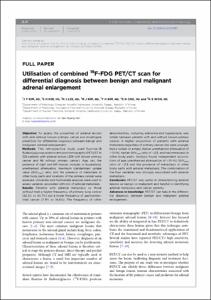KUMEL Repository
1. Journal Papers (연구논문)
1. School of Medicine (의과대학)
Dept. of Nuclear Medicine (핵의학)
Utilisation of combined 18F-FDG PET/CT scan for differential diagnosis between benign and malignant adrenal enlargement
- Keimyung Author(s)
- Won, Kyoung Sook; Kim, See Hyung; Lee, Hee Jung; Kim, Mi Jeong; Kim, Young Hwan
- Journal Title
- British Journal of Radiology
- Issued Date
- 2013
- Volume
- 86
- Issue
- 1028
- Abstract
- Objective:To assess the properties of adrenal lesions with and without known primary cancer and investigate predictors for differential diagnosis between benign and malignant adrenal enlargement.
Methods:This retrospective study used fluorine-18 fludeoxyglucose positron emission tomography (PET)/CT in 325 patients with adrenal lesions (229 with known primary cancer and 96 without primary cancer). Age, sex, the presence of right and left masses, nodules or hyperplasia, unenhanced attenuation, maximum standardised uptake value (SUVmax) ratio, and the presence of metastasis in other body parts and locations of the primary cancer were assessed. Univariate and multivariate analyses were used to assess variables associated with risk of adrenal metastasis.
Results:Patients with adrenal metastasis vs those without had a higher frequency of primary lung cancer (52.3% vs 30.7%) but a lower frequency of gastrointestinal cancer (7.9% vs 16.6%). The frequency of other abnormalities, including adenoma and hyperplasia, was similar between patients with and without known primary cancer. A higher proportion of patients with adrenal metastasis regardless of primary cancer site were younger, had a nodule or a mass, had an unenhanced attenuation of >10 HU, had an SUVmax ratio of >2.5, and had metastasis in other body parts. Analysis found independent associations of age, unenhanced attenuation of >10 HU, SUVmax ratio of >2.5 and the presence of metastasis in other body parts with adrenal metastasis. The combination of the four variables was strongly associated with adrenal metastasis.
Conclusion:PET/CT was useful in characterising adrenal lesions as benign or malignant and helpful in identifying adrenal metastasis and cancer severity.
Advances in knowledge:PET/CT can help in the differential diagnosis between benign and malignant adrenal enlargement.
- Publisher
- School of Medicine
- Citation
- J Y KIM et al. (2013). Utilisation of combined 18F-FDG PET/CT scan for differential diagnosis between benign and malignant adrenal enlargement. British Journal of Radiology, 86(1028), 20130190–20130190. doi: 10.1259/bjr.20130190
- Type
- Article
- ISSN
- 0007-1285
- Appears in Collections:
- 1. School of Medicine (의과대학) > Dept. of Nuclear Medicine (핵의학)
1. School of Medicine (의과대학) > Dept. of Radiology (영상의학)
- 파일 목록
-
-
Download
 oak-aaa-00720.pdf
기타 데이터 / 714.93 kB / Adobe PDF
oak-aaa-00720.pdf
기타 데이터 / 714.93 kB / Adobe PDF
-
Items in Repository are protected by copyright, with all rights reserved, unless otherwise indicated.